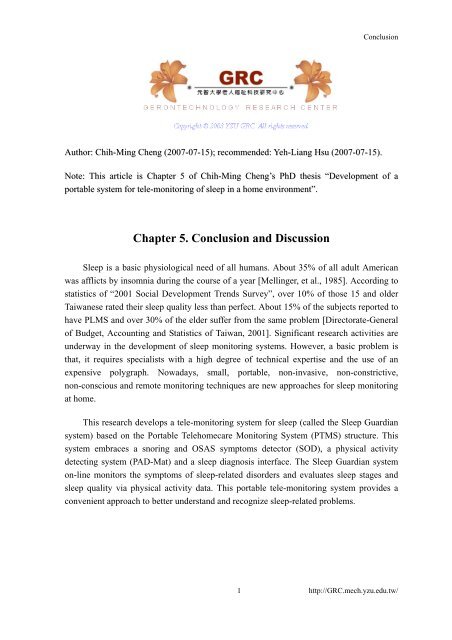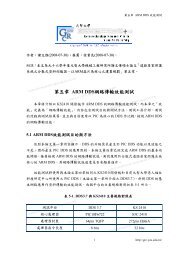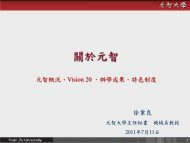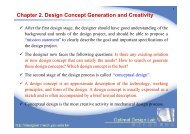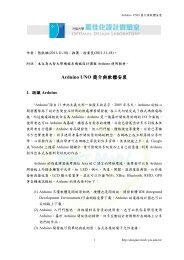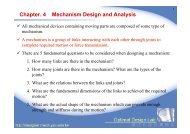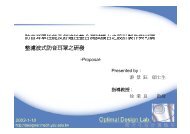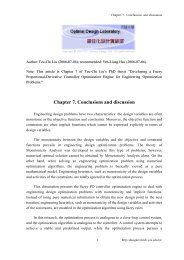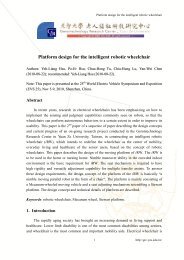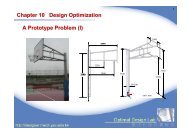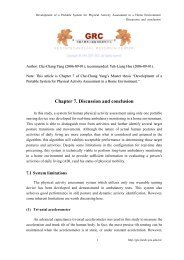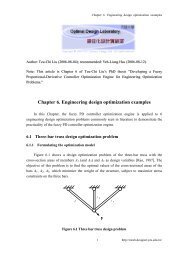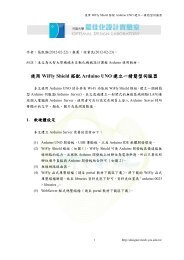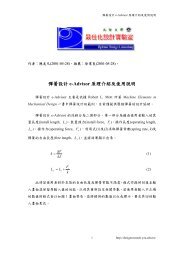Chapter 5. Conclusion and Discussion
Chapter 5. Conclusion and Discussion
Chapter 5. Conclusion and Discussion
Create successful ePaper yourself
Turn your PDF publications into a flip-book with our unique Google optimized e-Paper software.
<strong>Conclusion</strong><br />
Author: Chih-Ming Cheng (2007-07-15); recommended: Yeh-Liang Hsu (2007-07-15).<br />
Note: This article is <strong>Chapter</strong> 5 of Chih-Ming Cheng’s PhD thesis “Development of a<br />
portable system for tele-monitoring of sleep in a home environment”.<br />
<strong>Chapter</strong> <strong>5.</strong> <strong>Conclusion</strong> <strong>and</strong> <strong>Discussion</strong><br />
Sleep is a basic physiological need of all humans. About 35% of all adult American<br />
was afflicts by insomnia during the course of a year [Mellinger, et al., 1985]. According to<br />
statistics of “2001 Social Development Trends Survey”, over 10% of those 15 <strong>and</strong> older<br />
Taiwanese rated their sleep quality less than perfect. About 15% of the subjects reported to<br />
have PLMS <strong>and</strong> over 30% of the elder suffer from the same problem [Directorate-General<br />
of Budget, Accounting <strong>and</strong> Statistics of Taiwan, 2001]. Significant research activities are<br />
underway in the development of sleep monitoring systems. However, a basic problem is<br />
that, it requires specialists with a high degree of technical expertise <strong>and</strong> the use of an<br />
expensive polygraph. Nowadays, small, portable, non-invasive, non-constrictive,<br />
non-conscious <strong>and</strong> remote monitoring techniques are new approaches for sleep monitoring<br />
at home.<br />
This research develops a tele-monitoring system for sleep (called the Sleep Guardian<br />
system) based on the Portable Telehomecare Monitoring System (PTMS) structure. This<br />
system embraces a snoring <strong>and</strong> OSAS symptoms detector (SOD), a physical activity<br />
detecting system (PAD-Mat) <strong>and</strong> a sleep diagnosis interface. The Sleep Guardian system<br />
on-line monitors the symptoms of sleep-related disorders <strong>and</strong> evaluates sleep stages <strong>and</strong><br />
sleep quality via physical activity data. This portable tele-monitoring system provides a<br />
convenient approach to better underst<strong>and</strong> <strong>and</strong> recognize sleep-related problems.<br />
1<br />
http://GRC.mech.yzu.edu.tw/
<strong>Conclusion</strong><br />
<strong>5.</strong>1 Possible applications of the Sleep Guardian system<br />
Several applications are purposed in this research. The Sleep Guardian system can be<br />
used as prior examinations for sleep-related breathing disorders <strong>and</strong> PLMS, a tool for sleep<br />
quality evaluating <strong>and</strong> an assistant for nursing home supporting.<br />
(1) Sleep-related breathing disorder<br />
In clinic practices, excessive daytime sleepiness is the major symptom of patients<br />
with obstructive sleep apnea syndrome (OSAS). Epworth Sleepiness Scale (ESS), a simple<br />
questionnaire measuring the general level of daytime sleepiness, is used to forewarn the<br />
possibility of OSAS. Patients with higher scores of ESS (over 10) were assigned to have<br />
PSG examinations. Although some researches showed the relation of sleepiness to<br />
respiratory disturbance [Gottlieb, et al., 1999], some others also have different point of<br />
view. Chervin <strong>and</strong> Aldrich used regression models <strong>and</strong> retrospective data from a relatively<br />
large series of 237 patients <strong>and</strong> concluded that the ESS may not reflect objective measures<br />
of sleep apnea [Chervin <strong>and</strong> Aldrich, 1999]. Guilleminault et al. also pointed out that<br />
respiratory disturbance index <strong>and</strong> oxygen saturation indices did not significantly correlate<br />
with daytime sleepiness [Guilleminault, eta al., 1988]. However, the ESS tends to amplify<br />
the possible of OSAS. In this research, “Development of a portable system for<br />
tele-monitoring of sleep in a home environment”, 18 patients who had high scores were<br />
selected for one-night PSG examination. Only 5 of 18 patients (27.8%) were classified as<br />
OSAS patient by PSG.<br />
The SOD showed a good performance in detecting snore <strong>and</strong> locating OSAS<br />
segments (an average sensitivity of 94.0% <strong>and</strong> 79.6%). The SOD is not intended to be a<br />
diagnosis device for OSAS, instead, this portable device is to be used as a home appliance<br />
as a precautionary measure for monitoring snoring <strong>and</strong> OSAS.<br />
(2) Sleep quality assessment<br />
In this research, the sleep quality evaluation is based on the Pittsburgh Sleep Quality<br />
Index (PSQI). The PSQI was designed to differentiate between good <strong>and</strong> poor sleepers, <strong>and</strong><br />
to measures sleep disturbances using self-reports. Using a cut-off score of 5, high<br />
sensitivity <strong>and</strong> specificity of 89.6% <strong>and</strong> 86.5% was reported with the original publication<br />
of measure [Buysse, et al., 1988]. Nevertheless, PSQI scores did not correlate well with<br />
their PSG counterparts, with the strongest relationship between PSQI <strong>and</strong> PSG sleep<br />
latency being only r = 0.3.<br />
2<br />
http://GRC.mech.yzu.edu.tw/
<strong>Conclusion</strong><br />
The Sleep Guardian system provides a quantitative measurement of sleep disturbances<br />
<strong>and</strong> evaluates sleep quality with objective estimates by the PAD-Mat <strong>and</strong> the SOD.<br />
Sleep/Awake cycle was recognized by the PAD-Mat <strong>and</strong> was validated with good<br />
sensitivity <strong>and</strong> specificity in identifying sleep states (89.5% <strong>and</strong> 84.3%). This portable<br />
device is to be used as a home appliance for better underst<strong>and</strong>ing sleep problems.<br />
(3) Physical activity detection<br />
There are also motor disturbances that are triggered by sleep, such as restless legs<br />
syndrome (RLS) <strong>and</strong> periodic limb movements during sleep (PLMS). The PAD-Mat is a<br />
non-constrain approach to detecting motor disturbances in sleep.<br />
Besides motor disturbances monitoring <strong>and</strong> sleep quality assessment, the PAD-Mat<br />
can be used for detecting body position changes. Bed sore is a common problem in nursing<br />
home. Usually caregivers have to change the subject’s body position every 2 hour. Figure<br />
5-1 shows a 3-day history of a subject in a nursing home. Caregivers <strong>and</strong> family members<br />
can access the PAD-Mat for body activity tracking.<br />
Figure 5-1. 3-day history of a subject in a nursing home<br />
3<br />
http://GRC.mech.yzu.edu.tw/
<strong>Conclusion</strong><br />
<strong>5.</strong>2 Future work<br />
The future work of this research will focus on the commercialization of the system.<br />
More user trials are to be conducted to evaluate the user acceptance, clinical effect, <strong>and</strong><br />
economic analysis of the Sleep Guardian system. Besides the management interface<br />
described in <strong>Chapter</strong> 4, an IE user interface written in Java is to be developed, so that the<br />
caregiver can access SOD <strong>and</strong> PAD-Mat directly from any client PC. With the two sensors<br />
(SOD <strong>and</strong> PAD-Mat) <strong>and</strong> the PTMS information structure, there are more possible<br />
applications in home telehealth. Other possible applications are to be explored in the<br />
future.<br />
Reference<br />
Chervin, R. D., <strong>and</strong> Aldrich, M. S., “The Epworth Sleepiness Scale may not reflect<br />
objective measures of sleepiness or sleep apnea”, Neurology, 1999, v. 52, pp.12<strong>5.</strong><br />
Directorate-General of Budget, Accounting <strong>and</strong> Statistics of Taiwan, 2001, Social<br />
Development Trends Survey.<br />
Gottlieb, D. J., Whitney, C. W., Bonekat, W. H., Iber, C., James, G. D., Lebowitz, M.,<br />
Nieto, F. J. <strong>and</strong> Rosenberg, C. E., “Relation of Sleepiness to Respiratory Disturbance<br />
Index”, American Journal of Respiratory <strong>and</strong> Critical Medicine, 1999, v. 159, n. 2, pp.<br />
502-507.<br />
Guilleminault, C., Partinen, M., Quera-Salva, M.A., Hayes, B., Dement W. C. <strong>and</strong><br />
Nino-Murcia, G., “Determinants of daytime sleepiness in obstructive sleep apnea”, Chest,<br />
1988, v. 94, pp.32-37.<br />
Mellinger, G. D., Balter, M.B. <strong>and</strong> Uhlenhuth. E.H., “Insomnia <strong>and</strong> its treatment:<br />
Prevalence <strong>and</strong> correlates”, Archives of General Psychiatry, 1985, v. 42, n. 3, pp.225-232.<br />
4<br />
http://GRC.mech.yzu.edu.tw/


